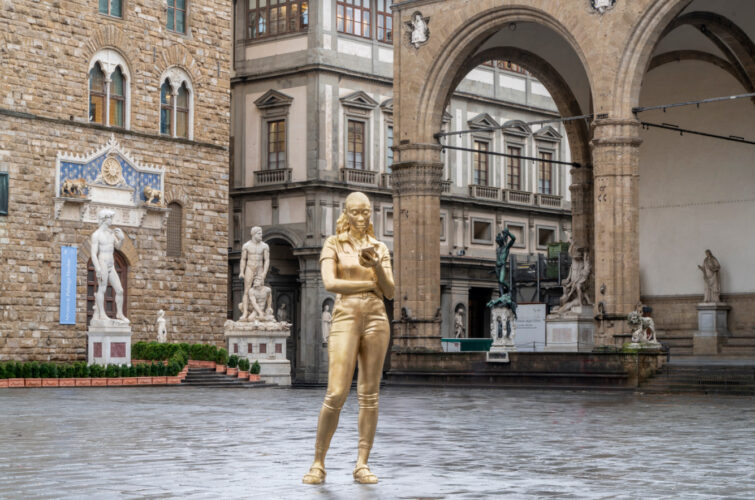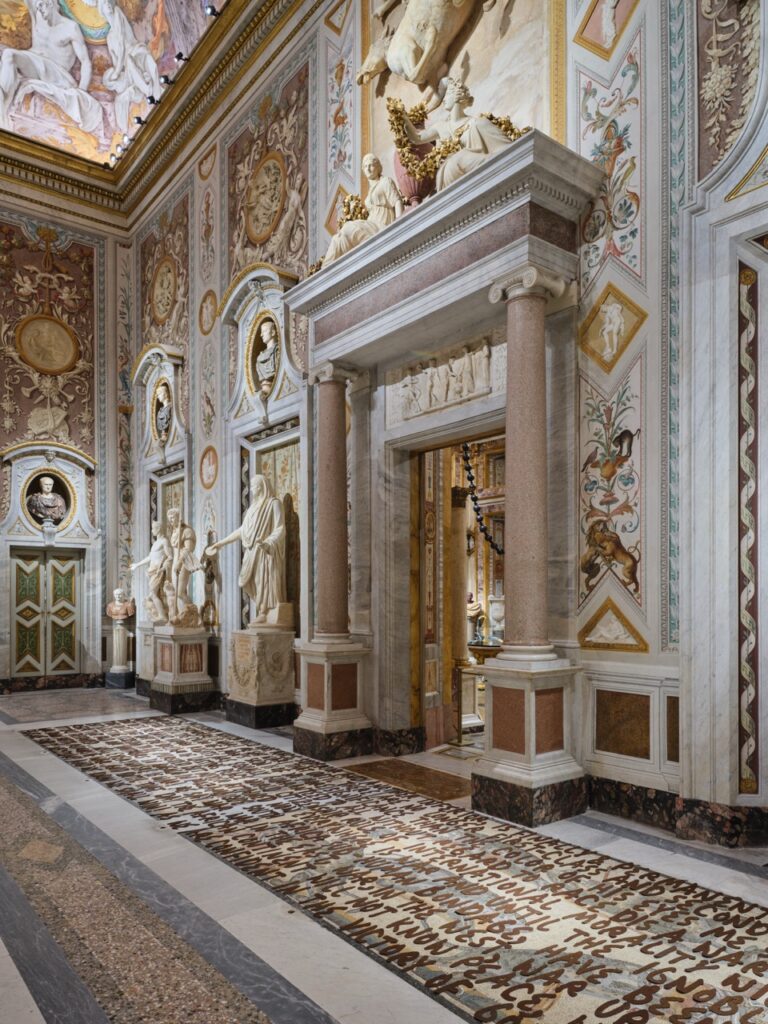Of all the museums charged with the preservation of artistic traditions, those dedicated to the history of Western art are the only ones that seem increasingly unhappy with their lot. To compensate for the perceived lack of diversity in Greek and Roman art as well as in the Old Masters, canonical collections across Europe and America feel the need to place more contemporary art in their midst, often from traditionally underrepresented demographics of artists. It is, however, worth asking: beyond making the curators of these institutions feel better about themselves, what is the point of these juxtapositions of ancients and moderns?
Florence is currently hosting the exhibition “Thomas J Price in Florence” by the eponymous British sculptor. Since 2020, Price has made his name by creating large bronze statues of black women, often looking at their phones, including one recently displayed in New York’s Times Square. This show is no different, featuring sculptures and individual heads of black people, displayed in the Palazzo Vecchio and in the Museo Novecento. The piece that attracted the most attention from the media was Price’s Time Unfolding, a twelve-foot-high gilded-bronze statue of a black woman staring at her phone. This sculpture was placed in the center of the Piazza de la Signoria, not far from where the copy of Michelangelo’s colossal David now stands, in front of the Palazzo Vecchio.

Thomas J Price, Time Unfolding, Gilded bronze, Museo Novecento, Florence, Italy.
The statue is clearly meant to be read as a challenge to the nearby mythological and biblical heroic sculptures of Michelangelo, Cellini, and Giambologna. According to the curator Sergio Risaliti, Price’s “language, radically contemporary, appropriates these ‘ideal’ forms to regenerate them, entrusting them with the celebration of identity.”
What are these ideals that are in need of regeneration? Michelangelo’s David might be an instructive example. When the sculpture was finished in 1504, the statue was originally meant to be placed high up on the roof of Florence’s Duomo. When the statue was unveiled, however, the sculpture was deemed too perfect to stand so far above the ground. After a lengthy public debate, Michelangelo’s statue was placed in front of the Palazzo Vecchio, the city’s political center, as a symbol of the Florentine republic, which had recently attained freedom from Medici rule.
Michelangelo’s David expresses a universal ideal of faith and courage. By contrast, Price’s Time Unfolding, while aiming to celebrate the dignity of mundane and everyday modernity, unwittingly reminds us how hollow, phony, and philistine our overweening contemporary culture is. While the Renaissance art of the piazza elevates the viewer by presenting us with an ideal of divinely inspired potential and purpose, Price’s sculpture achieves the kind of instant gratification that looking in the mirror provides. The sculpture, which lacks a pedestal, is certainly accessible to all, but only because it appeals to the lowest common denominator of digital, navel-gazing contemporary life as it turns its back to the greatest sculptors of Western art history.
In an interview given to a Florentine magazine, Price makes this meaning of his work explicit: “My sculptures represent what we are: common people, not heroes, not conquerors or mythical creatures. These sculptures represent us and seeing ourselves represented this way, on an enormous scale, should help us realize the power that each of us has. The more we value ourselves, the more we are willing to value other people.” With such platitudes, the artist himself places his work in the realm of pure kitsch.
Not to be outdone by Florence, the Galleria Borghese in Rome has mounted an exhibition entitled “Black Soil Poems” that explores similar themes as “Thomas J Price in Florence.” Like Price, the Kenyan American artist Wangechi Mutu seeks to “offer a counterbalance to the site’s classical order, challenging idealized form and linear narrative in favor of ambiguity, otherness, and spiritual presence,” per the museum. It is striking that the Borghese would so casually reduce the intricacy of its own collection to “linear narratives.” Does Titian’s Sacred and Profane Love lack ambiguity? Is there not enough otherness in Bernini and Caravaggio, no haunting spiritual presence in Raphael’s Deposition?
Although the museum claims that Mutu’s “sculptures never obscure the Borghese collection; but rather, appear as subtle additions,” the reality is that the works are anything but subtle. Highlights include Suspended Playtime, an installation of dozens of spheres made of black plastic bags of varying sizes hanging from the eighteenth-century frescoed ceiling. Cue the parodic explanation: “They challenge the architectural symmetry of the space, replacing its polished illusion of mastery with the unpredictable rustle of adaptation.” Needless to say, “the unpredictable rustle of adaptation” completely overshadows the Baroque pieces in the gallery.

Wangechi Mutu, Suspended Playtime, Plastic, wire, and twine, Galleria Borghese, Rome, Italy.
The Grains of Words is an even more egregious example of a temporary exhibition preventing the admiration of an older work. This piece is composed of lines of words made of tea and coffee, which sit atop an ancient Roman mosaic. The words are from the lyrics of Bob Marley’s song“War” (1973), which called for race war and violence as long as any semblance of racism remained in the world. The Grains of Words obscures and covers the Roman work, presumably because Roman art is part of the ideology of white supremacy that both Bob Marley and Mutu are declaring war against. Making a classical work of art illegible by using someone else’s words to advance an already dominant sociopolitical worldview can hardly be described as moving away from simplistic linear narratives.

Wangechi Mutu, The Grains of Words, Coffee and tea, Galleria Borghese, Rome, Italy.
Mutu’s other works, which include various hybrid anthropomorphic and theriomorphic sculptures made out of soil, wood, and bronze, pay tribute to her familial and Kenyan heritage. This is all well and good, but just as in the case of Price’s statue in Florence, the nagging question remains: beyond the novelty factor, why are these works here?
In both Rome and Florence, curators describe wanting to establish a dialogue between canonical works of their collection and more contemporary artworks. But what dialogue can there be between works that represent only a particular politically driven modern ethno-narcissism, and works that deal with the human condition in all of its tragic beauty?
















